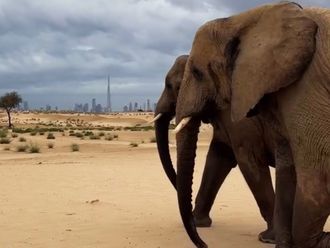When engineer and nature enthusiast Mayur Kamath, 24, spotted a tiger in the forests of Sanjay Gandhi National Park (SGNP), Borivili, early last month, his dream of having the big animal back in Mumbai after 82 years had come true.
He becomes the first person to have a glimpse of the tiger that has returned to this city. "I feel so proud to have the tiger in this park which has meant a lot for all my colleagues involved in the activities of saving reptiles and birds and releasing them in the wild," he told Gulf News.
When news of a tigress entering the Nagla area, on the northern stretch of the SGNP, excited nature lovers, Kamath took it up as a challenge to track the animal himself.
A.R. Bharti, deputy conservator of forests, coordinated a 10-day trip into the forests, starting off with an orientation programme for Kamath, his two friends and two forest guards, as they started on June 2.
With a base at Nagla block, the team, though one left after a couple of days, saw all the signs of the big predator on the prowl.
"There were pug marks everywhere and we spotted at least six carcasses of bulls, indicating that the kill was done by a big animal." During the day, the team, including young Pradeep Dalvi, a 10th standard student, monitored the movement of the tiger, collecting hair from bushes and observing the pug marks.
"But at night, Dalvi stayed alone on the machan and I roamed in the forest to track this amazing animal," he says.
He also had to walk barefoot in the marshy mangroves since his shoes would sink in the soft soil and become heavy with the mud.
He says he is not afraid "since I have been tracking tigers for six years. It is important to avoid a face to face conflict and therefore a safe distance has to be maintained." However, the moment he is aware of a tiger in the vicinity, he normally climbs up a tree.
Having often moved in the Melghat forest reserve, the toughest terrain to see tigers, when he was studying engineering in nearby Akola, he felt he had the capability to get on.
And on June 7-8, at around 2.30 am, as he wandered alone in the forest, he felt the tiger's presence in the area and quickly climbed a tree.
"Imagine, I was on a treetop with a video camera in one hand and an ordinary torch on the other. I could see the tiger for a full 22 minutes but could only get four seconds of the animal on the film."
He observed the animal carefully to make sure it was not from the circus. "She was a healthy one and I believe there is also another tiger in the area, judging from the pug marks."
He says they were in the forest for 10 days managing on a diet of roasted potatoes and onions.
Bharti, who coordinated Kamath's venture to trace the tiger, told this paper, "We encouraged Kamath because he is genuinely interested in conservation."
Right from April 14, when the pugmarks were seen, forest officials have been out to monitor the tiger's movement since this animal never stays in one place. "We had sent samples of scat (droppings), pugmark prints and hair to the Wildlife Institute of India in Dehradun."
Bharti thinks the tiger could have migrated from the forests in Dangs in Gujarat and moved along the forest corridor through Nashik into SGNP.
"It's certainly a large tigress, around two-and-a-half metres in length, and seems to be quite healthy." It is now confirmed that Mumbai city has a tiger in the wild after more than eight decades.
Mumbai leaps into tiger territory
When engineer and nature enthusiast Mayur Kamath, 24, spotted a tiger in the forests of Sanjay Gandhi National Park (SGNP), Borivili, early last month, his dream of having the big animal back in Mumbai after 82 years had come true.












